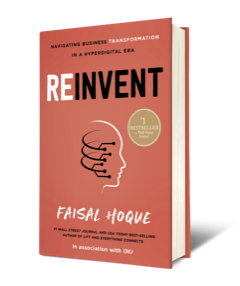Organizations of all types have shredded hundreds of millions of dollars on poorly planned and executed swipes at transformation.
BY FAISAL HOQUE
Organizational transformation is a journey that never stops. It’s up to you to keep steering in the correct direction. Accordingly, staying on the right course with your organizational transformation mandates your continued evolution as a leader as well.
 A successful transformation is certainly a testimony to your leadership skills. Not everyone can help devise, implement, and motivate to the level required by sweeping change—the steep failure rate attests to that. And, as an accomplished leader, you’re well aware that meaningful change can’t possibly take place without equal conviction and energy from everyone on your team. Acknowledged inclusion is everything. But the challenge is by no means over. As you and your organization move forward, so too must you continue to hone, sharpen, and, if need be, change elements of your leadership. Your organization isn’t what it was yesterday—and neither should you stay the same. Organizations of all types have shredded hundreds of millions of dollars on poorly planned and executed swipes at transformation.
A successful transformation is certainly a testimony to your leadership skills. Not everyone can help devise, implement, and motivate to the level required by sweeping change—the steep failure rate attests to that. And, as an accomplished leader, you’re well aware that meaningful change can’t possibly take place without equal conviction and energy from everyone on your team. Acknowledged inclusion is everything. But the challenge is by no means over. As you and your organization move forward, so too must you continue to hone, sharpen, and, if need be, change elements of your leadership. Your organization isn’t what it was yesterday—and neither should you stay the same. Organizations of all types have shredded hundreds of millions of dollars on poorly planned and executed swipes at transformation.1. FOLLOW THE MONEY
They must focus on the business and understand how it creates value. Leaders must understand the business strategy: Regarding each product market, is the firm in an exploratory or exploitative posture? This assumes that the organization has a strategy that is well articulated and supported by appropriate structures, processes, and information.
2. KNOW THAT MANAGING TECHNOLOGY IS AS IMPORTANT AS THE TECHNOLOGY ITSELF
The next generation of leaders will understand—or should if they want to succeed—that they must invest in managing technology as well as in the technology itself. If there is any remaining doubt today, there will not be in the future; technology, per se, is an equalizer. Only in the management of it can firms eke out an advantage.
3. UNDERSTAND WHAT TECHNOLOGY DOES
Unless they appreciate that technology often plays a critical role in establishing or maintaining a strategic position, future leaders may well spend inappropriately. But that appreciation must evolve to an understanding of how the various types of technology—those that enable transactions, decisions, or relationships, for example—contribute to an organization’s strategic actions. More often than not, in the first half century of technology, it was thought about only tactically.
4. SEE THROUGH WALLS
Tomorrow’s leaders will be far more comfortable with deriving value through partnerships and other types of engagements. They must understand the role technology plays in enabling these partnerships and learn to manage the technology that stretches across internal organizational boundaries.
5. MANAGE BUSINESS AND TECHNOLOGY AS ONE
The moments of dissension and the finger-pointing at failures will disappear as executives come to see that technology failure is often due to weak or nonexistent business strategy or failure to create a business-driven technology strategy. Alignment will increasingly be seen as only the first step; it will occur to all that the design and management of business cannot be done apart from the design and management of technology.
6. SCRAP THE ORG CHART
We are already seeing the blending of corporate roles. It will be commonplace in the future. Leaders will have to be comfortable in both the business and technology realms. This re-identity is already underway.
7. GET UNDERNEATH THE HOOD
Leaders of the next generation must be able to discern business processes below the overarching posture of an organization that advance strategy. Moreover, they must see technology as part and parcel of these processes; the two are inseparable. This is going to require untying the functional straitjackets in which many organizations have existed.
8. GET COMFORTABLE WITH SPEED
Is it too much of a cliché to say that everything will move faster and faster, that interconnectivity makes the whole world our playing field, and that we must give up command and control so that our people on the edges of the organization can react to events in real time? And that this is an entirely new way of thinking about management and leadership? And that even if we pay lip service to it today, it will be very hard to accomplish?
Above all, what really matters moving forward is your understanding and recognition of the scope of change, in which you are a valuable player. Armed with that powerful mindset, you’ve positioned yourself to be just as aware of how different your organization will look in the future—and how you can adapt to help that journey continue toward growth and further success.
Excerpt published with permission from REINVENT: Navigating Business Transformation in a Hyperdigital Era by Faisal Hoque (Fast Company Press, 2023), in association with IMD. All rights reserved.
Original article @FastCompany.
[Photo: Rawpxiel]















